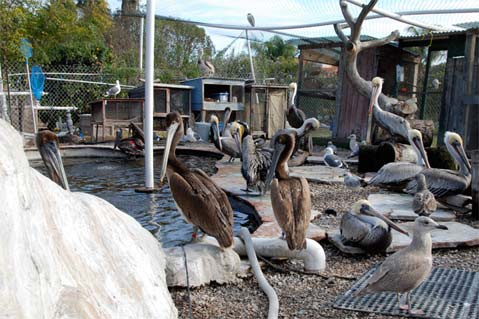Mysterious Disease Sickening Pelicans
Disoriented, Fatigued Birds Found All Over West Coast

Something is seriously wrong with the Brown Pelicans that can often be seen cruising the coastline in single-file formation, surfing the air just above waves, or diving for fish. Reports from Baja California to Washington all note the same mysterious symptoms, though nobody has been able to identify the cause.
The pelicans are being found in unusual locations, often far inland, and appear fatigued and disoriented. Some are already dead. Bruising has also been noted on their pouches and feet.
“It’s not just Santa Barbara, and it’s not just California,” said Julia Parker, director of animal affairs at Santa Barbara Wildlife Care Network.

The Brown Pelican is listed as an endangered species, and Parker said that people should call the Wildlife Care Network if they encounter pelicans under odd circumstances. This includes those that appear to be in harm’s way, weak or wobbly, or near people. “Call it in to us here at the center: We can bring it in and give it treatment,” she said.
As of January 8, 265 Brown Pelicans were reported dead or sick in California, with more than 100 receiving treatment. “All the birds seem somewhat disoriented,” Parker said. As of Tuesday, a total of 31 pelicans were being treated by the wildlife network. Parker said they received more than two dozen calls over the weekend.
Although it is normal for number of juvenile pelicans to die off or be rescued at this time of year, approximately half of the afflicted birds are adults. This is in sharp contrast to normal years. Parker explained that usually it is juveniles that haven’t learned to fish who are found dead or who need rescuing, but this year the illness is apparent in greater numbers of adults.
In the past, the neurotoxin domoic acid was thought to be the culprit. Birds and marine mammals ingest domoic acid by eating fish and shellfish. It can cause permanent short-term memory loss, brain damage, and even death in severe cases. It is produced by diatoms, and is therefore abundant during harmful algal blooms, such as red tides.
David Caron, a biology professor at USC, has been conducting the blood tests for the presence of domoic acid. In his initial findings, only three of six birds tested positive for domoic acid. He then tested 12 more pelicans, out of which only one tested positive. He added that in those pelicans in which he found domoic acid it was not in tremendously high levels. “There is another primary influence on the health of the birds,” said Caron, who added that a possible cause of the mysterious malady is the pelicans having stayed too long in the north before migrating for the winter. Population counts of Brown Pelicans in Oregon reported unprecedented numbers at Christmastime, he said. Accordingly, it is believed that the birds were debilitated as they were hit by storms when migrating out of their summer states.
While it has been suggested that domoic acid may be playing a secondary role to the larger problem, it does not explain the fatigue apparent in the bids, which are being found thin and weak. It also does not explain the bruising that some of the affected birds exhibit, which Parker said is usually from internal bleeding. Additionally, the birds aren’t suffering from seizures, which is a common symptom of domoic acid poisoning.
Caron also said they have not seen any massive algal blooms, with any numbers being 100 times less than what would be thought of as a major toxic event. Additionally, he said that no other marine birds or mammals have been affected.



